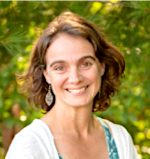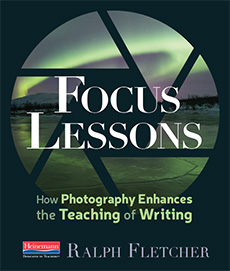Using Photography to Enliven Student Writing
Focus Lessons: How Photography Enhances the Teaching of Writing
By Ralph Fletcher
(Heinemann, 2019 – Learn more)

Ralph Fletcher’s Focus Lessons is an invitation. The staff-room kitchen kind of invitation, in which a colleague unfolds a new strategy, one you find yourself nodding along with as you warm up your leftover pasta in the microwave. It’s a friendly invitation, and an exciting one.
I first encountered Fletcher’s invitation through an excerpt, a single craft lesson on “arresting detail” posted on the Heinemann website. I read through the lesson, gave my students permission to retrieve their cell phones, and headed out to the pre-kindergarten playground.

As Fletcher states in his introduction, “It turns out that photography can illuminate the craft of writing and help us understand it in a whole new way” (xiv).
Lessons crafted to extend vision
At the heart of Fletcher’s new book lies a series of craft lessons in which he discusses concepts including tension, point of view, and mood in a photographic context followed by a writing connection. The craft lessons are “designed to fit into the mini lesson portion of your writer’s workshop” (32).
Fletcher does not provide a script, but rather offers a series of ingredients: a photograph, some discussion of the process, photo tips, a writing excerpt, and writing connections. I found the unscripted approach refreshing. It reinforced the feeling that the book is a conversation, or the extension of one, started in the staff room among trusted colleagues.
For those looking for more structure, he does provide a suggested outline for the lessons, guiding questions to help students discuss photographs, as well as access to full-resolution photos in the online resources. A series of appendices provide excellent suggestions for finding photographs, lists of photographers’ websites, and two compelling projects that connect photography and literacy.
The conversation between the pages
While the craft lessons are an important part of Focus Lessons, the conversation that takes place between its pages is much larger. Fletcher begins the story with his journey: his first forays into the practice of photography. He reminds us of the importance of showing up, building stamina and volume.
Most important, he reminds us as teachers what it means to be a student: the power carried in an offhanded comment, the sting of uncertainty and failure. A chapter titled “Upon Reflection” is a meditation on the interplay between photography and writing, between an image and its reflection, and upon the act of reflecting. This beautiful essay reminded me that Fletcher is first and foremost a master writer.
While the craft lessons are meant to fit into a mini lesson, I found my lessons stretching much longer. Whether taking the time to photograph or analyzing others’ work, the photography became compelling in itself and left little time for writing.
Ultimately, I believe my students will have a deeper understanding of mood and tension because of these lessons when they return to their drafts. Even so, I appreciated the concrete ideas presented in the chapter “How Photographs Spark Writing.” My students were writing, I realized – in captions, discussion, and peer feedback.
Photographing to learn
Subsequent chapters offer a wider angle on how to use photography in the classroom. “What’s happening in this photograph” provides hands-on strategies for helping students engage with “reading” photographs and exploring them deeply. “Photographing to learn” offers ways to use photography as a learning tool beyond the writing class to document processes.
As a young woman I studied ballet, and I both loved and loathed the VHS tape that my teacher handed me after a performance. From those videos I saw my performance from the audience’s perspective. Photographs (or videos) allow us to zoom in, pause, analyze, and yes improve.
Fletcher has clearly made the rounds, sharing his experience with and excitement about photography with friends and teachers around the country. As he recounts their conversations in his book, their voices provide feedback, anecdotes, and inspiration. I pull up a seat to the table eager to join the conversation and accept the invitation.
Jeny Randall teaches 6th grade Language Arts and science at Saratoga Independent School in New York State. As Middle School Coordinator, she oversees the curriculum and program development for grades 6 – 8. Outside of school Jeny teaches yoga, reads whatever students send her way, and spends time with her family, outside if possible.





































Wow, I’m honored by this thoughtful review. Jeny really “gets” the spirit of my book. What more can an author hope for?